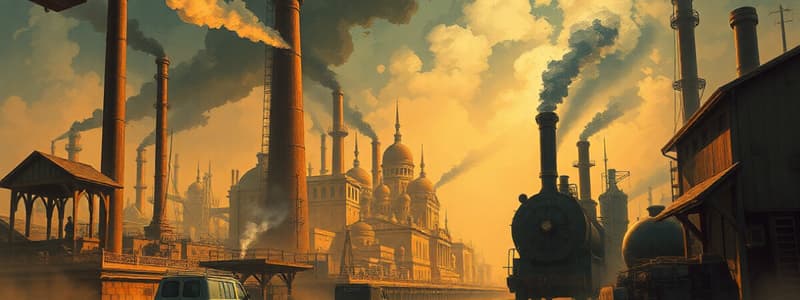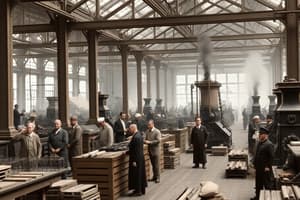Podcast
Questions and Answers
Which inventor was notable for creating a research lab that was able to produce an invention every 10 days?
Which inventor was notable for creating a research lab that was able to produce an invention every 10 days?
- Thomas Edison (correct)
- Alexander Graham Bell
- Gustavus Swift
- Christopher Sholes
Which of these inventions enabled the instantaneous communication of messages?
Which of these inventions enabled the instantaneous communication of messages?
- Telephone (correct)
- Typewriter
- Electric Power Plant
- Refrigerated Railroad Car
Which inventor's creation significantly increased the speed at which communication was possible?
Which inventor's creation significantly increased the speed at which communication was possible?
- Thomas Edison
- Christopher Sholes (correct)
- Alexander Graham Bell
- Gustavus Swift
Which individual is credited with inventing a method to ensure that food products could travel longer distances without spoiling?
Which individual is credited with inventing a method to ensure that food products could travel longer distances without spoiling?
Which of these inventions was most directly responsible for making life easier for the general public?
Which of these inventions was most directly responsible for making life easier for the general public?
Which of the following was NOT a key effect of the rise of the steel industry in the United States?
Which of the following was NOT a key effect of the rise of the steel industry in the United States?
What is the term for the practice of controlling all steps in the production process of a product, as exemplified by Andrew Carnegie's steel business?
What is the term for the practice of controlling all steps in the production process of a product, as exemplified by Andrew Carnegie's steel business?
What was John D. Rockefeller's primary contribution to the American economy?
What was John D. Rockefeller's primary contribution to the American economy?
What is the term for someone who donates their wealth to charitable causes, as Andrew Carnegie did?
What is the term for someone who donates their wealth to charitable causes, as Andrew Carnegie did?
What is the main difference between the impact of Andrew Carnegie's steel industry and John D. Rockefeller's oil industry?
What is the main difference between the impact of Andrew Carnegie's steel industry and John D. Rockefeller's oil industry?
Which of the following best describes the significance of J.P. Morgan's role in the American economy?
Which of the following best describes the significance of J.P. Morgan's role in the American economy?
How did banks contribute to the growth of businesses in the United States after the Civil War?
How did banks contribute to the growth of businesses in the United States after the Civil War?
What key characteristic distinguished the business practices of John D. Rockefeller from those of Andrew Carnegie?
What key characteristic distinguished the business practices of John D. Rockefeller from those of Andrew Carnegie?
What is the main focus of the first table?
What is the main focus of the first table?
What was the primary method used by larger railroad companies to force smaller companies out of business?
What was the primary method used by larger railroad companies to force smaller companies out of business?
According to the table, what was one of the main ways that Cornelius Vanderbilt influenced the railroad industry?
According to the table, what was one of the main ways that Cornelius Vanderbilt influenced the railroad industry?
What does the term 'railroad pools' refer to?
What does the term 'railroad pools' refer to?
Which of the following is NOT mentioned as a way that corporations were given large sums of money to start their businesses?
Which of the following is NOT mentioned as a way that corporations were given large sums of money to start their businesses?
What was a significant impact of the transatlantic cable, as mentioned in the table?
What was a significant impact of the transatlantic cable, as mentioned in the table?
Based on the information provided, what conclusion can be drawn about the relationship between larger railroad companies and smaller ones?
Based on the information provided, what conclusion can be drawn about the relationship between larger railroad companies and smaller ones?
What does the table suggest about the impact of technological innovations on the economy?
What does the table suggest about the impact of technological innovations on the economy?
Which invention played a key role in making cars more affordable and accessible to the general public?
Which invention played a key role in making cars more affordable and accessible to the general public?
What was the primary motivation behind the formation of labor organizations during the late 1800s?
What was the primary motivation behind the formation of labor organizations during the late 1800s?
How did the invention of the Kodak camera impact society?
How did the invention of the Kodak camera impact society?
What was the main objective of the Sherman Anti-Trust Act?
What was the main objective of the Sherman Anti-Trust Act?
Which of the following inventions had the most direct impact on the development of modern transportation?
Which of the following inventions had the most direct impact on the development of modern transportation?
Flashcards
Andrew Carnegie
Andrew Carnegie
A leading figure in the steel industry who also was a philanthropist.
Vertical Integration
Vertical Integration
A business strategy where a company controls all steps in the production process.
John D. Rockefeller
John D. Rockefeller
An influential businessman in the oil industry, known for creating a monopoly.
Monopoly
Monopoly
Signup and view all the flashcards
J.P. Morgan
J.P. Morgan
Signup and view all the flashcards
Philanthropist
Philanthropist
Signup and view all the flashcards
Effect of Steel Production
Effect of Steel Production
Signup and view all the flashcards
Effect of Oil Monopoly
Effect of Oil Monopoly
Signup and view all the flashcards
Corporate funding
Corporate funding
Signup and view all the flashcards
Railroad pools
Railroad pools
Signup and view all the flashcards
Small railroad companies
Small railroad companies
Signup and view all the flashcards
Cyrus Field
Cyrus Field
Signup and view all the flashcards
Transatlantic telegraph cable
Transatlantic telegraph cable
Signup and view all the flashcards
Importance of railroads
Importance of railroads
Signup and view all the flashcards
Discounts by larger railroads
Discounts by larger railroads
Signup and view all the flashcards
Vanderbilt's role
Vanderbilt's role
Signup and view all the flashcards
Telephone
Telephone
Signup and view all the flashcards
Light bulb
Light bulb
Signup and view all the flashcards
Refrigerated railroad car
Refrigerated railroad car
Signup and view all the flashcards
Typewriter
Typewriter
Signup and view all the flashcards
Electric power plant
Electric power plant
Signup and view all the flashcards
Kodak Camera
Kodak Camera
Signup and view all the flashcards
Moving Assembly Line
Moving Assembly Line
Signup and view all the flashcards
Flying Machine (Airplane)
Flying Machine (Airplane)
Signup and view all the flashcards
Gauge (Train Tracks)
Gauge (Train Tracks)
Signup and view all the flashcards
Sherman Anti-Trust Act
Sherman Anti-Trust Act
Signup and view all the flashcards
Study Notes
Industrial Revolution Innovations
- Steel Production: Andrew Carnegie made steel cheaply, enabling construction of skyscrapers and bridges, and better railways. He was also a philanthropist.
- Vertical Integration: Carnegie controlled all stages of steel production.
- Oil Industry Monopoly: John D. Rockefeller created a monopoly in the oil industry, driving out competition.
- Banking and Corporations: J.P. Morgan provided large sums of money to corporations, helping them start and grow.
- Railroad Industry: Cornelius Vanderbilt controlled parts of the railroad industry through business tactics. He also reorganized railroad companies, creating region-based services.
Key Inventions
- Transatlantic Cable (Cyrus Field): Allowed faster communication between Europe and the U.S.
- Telephone (Alexander Graham Bell): Revolutionized communication.
- Light Bulb (Thomas Edison): Improved daily life and enabled new technologies.
- Refrigerated Railroad Cars (Gustavus Swift): Enabled preservation of foods during transport.
- Typewriter (Christopher Sholes): Increased workplace efficiency in communication.
- Kodak Camera (George Eastman): Made photography more accessible.
- Assembly Line (Henry Ford): Resulted in mass production and affordability, changing manufacturing forever.
- Airplane (Orville & Wilbur Wright): Improved travel and transportation.
Working Conditions and Regulation
- Late 1800s Factory Conditions: Low pay, long hours, dangerous working conditions, and child labor were common.
- Labor Organizations: Formed to demand better wages, working conditions, and child labor laws.
- Sherman Anti-Trust Act: Intended to break up monopolistic industries. Initially ineffective, but eventually had an impact.
Studying That Suits You
Use AI to generate personalized quizzes and flashcards to suit your learning preferences.




